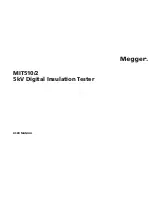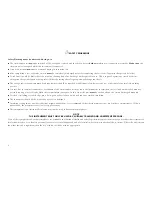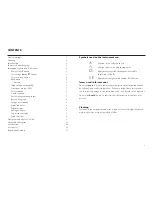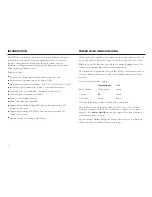
The guard terminal is at the same potential as the negative terminal. Since
the leakage resistance is effectively in parallel with the resistance to be
measured, the use of the guard causes the current flowing through surface
leakage to be diverted from the measuring circuit. The instrument
therefore reads the leakage of the insulator, ignoring leakage across its
surface. The display will show ‘FUS’ if the internal guard terminal fuse is
found to have blown. The instrument must be switched off to clear the
message before further testing is permitted. The fuse should be replaced
by an authorised repairer. The instrument may be used in the mean time if
the guard terminal not used. Refer to notes regarding measurements
above 100 G
Ω
on page 9.
Factory programming socket
This is a 9 pin socket under the hinged cover and is not for customer use.
Line input present LED
This is a green LED next to the power On/Off button on the front panel. It
is illuminated whenever the mains power is connected.
Test terminals
There are three test terminals , - and G. These terminals are
designed to accept only the test leads supplied. Shutters across the
terminals prevent accidental ingress of dirt and other objects. Test lead
plugs interlock with the shutters and are released by rotating the test lead
plug a quarter turn.
The Guard terminal is explained below and is only used in cases where
surface leakage currents need to be eliminated. Most measurements use
just the + and – terminals. The instrument’s internal voltage generator
drives the + terminal with respect to the – terminal, current being
measured in the – terminal.
Guard terminal
For basic insulation tests and where there is little possibility of surface
leakage affecting the measurement, it is unnecessary to use the guard
terminal i.e. if the insulator is clean and there are unlikely to be any adverse
current paths. However in cable testing for example, there may be surface
leakage paths across the insulation between the bare cable and the external
sheathing due to the presence of moisture or dirt. Where it is required to
remove the effect of this leakage, particularly at high testing voltages, a
bare wire may be bound tightly around the insulation and connected via
the third test lead to the guard terminal ‘G’.
7
































